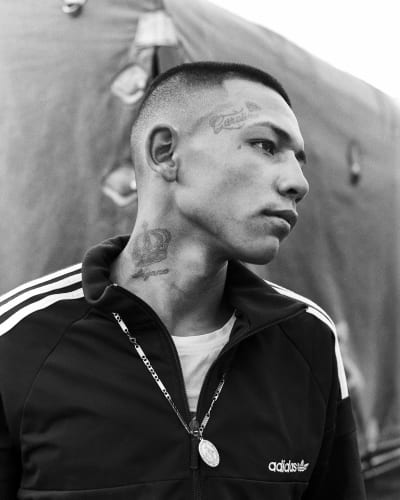Toes On The Nose, an exhibition of new paintings by Sebastián Rodríguez-Besa, presents four works created during a personal residency in Mexico City. This series emerges from a practice of daily observation and nomadic adaptation, where the artist discov- ered new modes of balance-both physical and creative-while constructing temporary spaces for intensive focus. The paintings are atmospheric and layered, brimming with the accumulated energy of a city that refuses easy categorization and an artistic process rooted in precarious attention.
In Mexico City, Rodríguez-Besa discovered the drive to return to a mode of observation that precedes the visual noise of familiar terri- tory-to inhabit the raw experience of seeing before interpretation sets in. These four paintings, created during a two-month stay with his partner, transcribe, layer, and obscure the daily accumulation of visual encounters: the particular light filtering through temporary windows, the colors bleeding from market stalls, the domestic rhythms of shared space converging with the restless energy of an unknown city, but culturally familiar to some degree.
Working between large and intimate scales, Rodríguez-Besa com- pulsively collected visual fragments throughout each day-sketches made on walks, observations stolen between routine and discov- ery, the archaeological sediment of growing up Latin American mingling with immediate Mexican cultural encounters. These landscapes of memory manifest as layered compositions where muted greens, dusty pinks, and weathered blues create atmospheric spaces punctuated by moments of vivid yellow and deep black. Popular iconography surfaces in these canvases, but so do the sound and smells of the markets and its food, the weight of temporary walls, fragments of underground aesthetics, and the recurring motif of spaces transformed into personal places. These images emerge and recede from the compositions depending on where the viewer focuses; none is prioritized over the other.
This nomadic studio practice meant learning to paint with whatever tools felt necessary-emotion channeled into gestural marks, focus applied with tangible vigor, uncertainty transformed into productive territory. Working from improvised setups, Rodríguez-Besa found moments of precarious balance where complete attention was re- quired, where the physical act of painting became a form of medita- tion on presence and risk. He repeated visual languages at different speeds and intensities, often cannibalizing imagery from his own
Clint Roenisch Gallery 190 St Helens Ave Toronto, Ontario, Canada
M6H 4A1
Toes On The Nose 21-28.8.2025
visual memory to strip away preconceived ideas and understand them differently within this new context. This activity reflected his process of navigating displacement while embracing the temporary as a form of home.
The varying scales-two large canvases, one medium, one small- er-function like the experience of being simultaneously grounded in domestic routine and unmoored by constant discovery. When daily observation became the organizing principle, everything demanded attention: the colors that refuse easy categorization, the particular chaos of streets, the quiet moments of shared intimacy. These painted moments collapse abstraction and figuration, where gestural marks suggest architectural fragments, organic forms, and half-remembered encounters with equal weight. Like windows
or doorways have functioned in Rodríguez-Besa's earlier work, Mexico City itself serves as a container for exploring how quickly foreign spaces become intimate when you're paying attention.
This series reveals what happens when you give yourself permis- sion to look longer, to engage with the challenging paintings that emerge, to recognize that challenge as necessary growth. The works ask viewers to see through and among multiple layers of informa- tion-personal history, immediate experience, cultural memory, and the accumulated iconography of contemporary life converging into new visual languages. Indeed, these paintings demand that we look, and look again, at our own capacity for observation and reinvention within borrowed spaces. In experiencing these works, viewers are invited to find their own moment of focused balance, their own toes on the nose-that sensation of complete attention at the edge of discovery.
In the book Los Detectives Salvajes (The Savage Detectives) by the writer and poet, Roberto Bolaño describes Mexico City as a chaotic and vibrant space, full of contrasts, where youth and decadence, poetry and violence, coexist in an atmosphere of searching and uncertainty. The city is another character, a labyrinth of streets, bars and marginal neighborhoods where the characters, especially the young poets, lose and find themselves in their search for poetry and for themselves.

